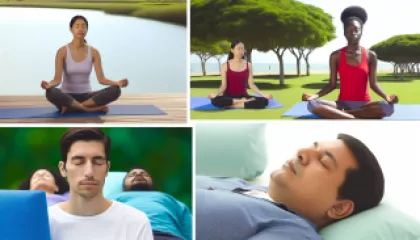5 Anxiety Relief Exercises That Changed My Life
Life can be overwhelming. We all encounter various stressors that push our emotional and mental capabilities to their limits. For me, this was never more true than when I faced debilitating anxiety. There were days when the world felt too heavy, my heart racing faster than a speeding bullet train and my mind filled with fears and worries. But through it all, I found solace in anxiety relief exercises. Today, I want to share the top five exercises that changed my life.
Exercise 1: Deep Breathing
It might sound simple, but deep breathing is an incredibly powerful tool for calming the mind. The beauty of deep breathing is its sheer simplicity - it requires no special equipment or location, just your lungs and a few moments of your time.
When anxiety gripped me, I would take slow, deep breaths, focusing solely on the sensation of air filling my lungs and the quiet rhythm of my heartbeat. This exercise brought me back from the edge of panic, grounding me in the present moment.
How to Perform Deep Breathing:
- Find a comfortable seat and close your eyes.
- Inhale slowly and deeply through your nose, letting your belly fill with air.
- Hold your breath for a moment.
- Exhale slowly, releasing the air through your mouth.
- Repeat this cycle for a few minutes or until you feel calmer.
Exercise 2: Progressive Muscle Relaxation
Another game-changer for me was progressive muscle relaxation. This technique involves tensing and then releasing different muscle groups, which promotes physical relaxation and helps alleviate feelings of anxiety.
During my darkest days, I found myself constantly tense, my muscles knotted tightly with stress. Progressive muscle relaxation taught me to release that tension, bringing a much-needed sense of relief.
How to Perform Progressive Muscle Relaxation:
- Start at your feet and work your way up to your facial muscles.
- Tense each muscle group (e.g., the legs, then the stomach, then the arms) for about 5 seconds, then relax for 30 seconds before moving on to the next group.
- Concentrate on the sensation of release when you let go of the tension.
Exercise 3: Guided Imagery
Guided imagery is a technique that involves visualizing a peaceful scene or situation. For me, this was a tranquil beach at sunset, waves gently lapping at the shore, the sky painted in hues of orange and pink.
Whenever I felt swallowed by anxiety, I would retreat to this safe haven in my mind. This exercise provided an escape from my worries and fears, if only for a little while.
How to Perform Guided Imagery:
- Close your eyes and imagine a relaxing scene. It could be a place you've been, a place you've dreamed of visiting, or even a made-up location.
- Try to involve all your senses. What can you see, hear, smell, taste, and touch in this place?
- Stay in your peaceful place for as long as you need to feel calmer.
Exercise 4: Yoga
Yoga is a physical practice that has been proven to reduce stress and anxiety. The combination of controlled breathing, physical poses, and meditation helped tame my racing thoughts and ease my anxious feelings.
Yoga not only improved my mental health but also enhanced my physical fitness and flexibility.
How to Perform Yoga:
There are numerous yoga poses and sequences designed for stress relief. I suggest starting with simple poses like Child's Pose, Cat-Cow Pose, and Corpse Pose.
You can find a plethora of free yoga classes online, making it easy to get started from the comfort of your own home.
Exercise 5: Mindfulness Meditation
The final anxiety-relief exercise that changed my life is mindfulness meditation. It’s a practice that involves focusing your mind on your experiences, such as your emotions or breathing, in the present moment.
Through mindfulness meditation, I learned to sit with my feelings of anxiety, acknowledging them without judgment or fear. Over time, this reduced the power they held over me.
How to Perform Mindfulness Meditation:
- Find a quiet space where you won't be disturbed.
- Set a timer for a manageable amount of time, such as five or ten minutes.
- Close your eyes and focus on your breath, noticing how it feels to inhale and exhale.
- If your mind wanders, gently bring it back to your breath without judgment.
In conclusion, these five exercises - deep breathing, progressive muscle relaxation, guided imagery, yoga, and mindfulness meditation - played instrumental roles in my journey to manage and overcome anxiety. They helped me regain control over my emotional state and taught me valuable coping mechanisms that I still implement to this day.
If you're struggling with anxiety, I hope you'll give these exercises a try. They may not be a magic cure-all, but they can provide a measure of relief in the midst of the storm.
I always remind myself of a quote by Lao Tzu, which perfectly encapsulates my journey: "If you are depressed, you are living in the past. If you are anxious, you are living in the future. If you are at peace, you are living in the present."
"If you are depressed, you are living in the past. If you are anxious, you are living in the future. If you are at peace, you are living in the present."Lao Tzu








